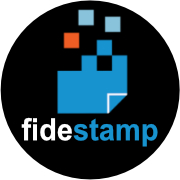A look inside the blockchain:
 Fidestamp
Fidestamp
Structure and Functions:
A blockchain is a system of recording information in a way that makes it difficult or impossible to change, hack, or cheat the system. A blockchain is essentially a digital ledger of transactions that is duplicated and distributed across the entire network of computer systems on the blockchain. Each block in the chain contains a number of transactions, and every time a new transaction occurs on the blockchain, a record of that transaction is added to every participant’s ledger. The decentralized database managed by multiple participants is known as Distributed Ledger Technology (DLT).
How does blockchain work?
The blockchain is a continuously growing list of records, called blocks. Each block contains a timestamp and a link to a previous block. Once a block is added to the chain, it cannot be changed without changing all subsequent blocks, which requires collusion of the network majority.
Blockchain’s key features:
Decentralization: Blockchains are decentralized, meaning they are not controlled by any single entity. This makes them more secure and resistant to fraud.
Transparency: All transactions on a blockchain are public and transparent, meaning anyone can view them. This makes it easier to track and audit transactions.
Immutability: Once a transaction is added to a blockchain, it cannot be changed or deleted. This makes blockchains a secure and tamper-proof way to store data.
The structure of a blockchain:
A blockchain is made up of a series of blocks, each of which contains a number of transactions. Each block is linked to the previous block using a cryptographic hash. This hash is a unique identifier that is generated based on the contents of the block. If any data in the block is changed, the hash will also change. This makes it very difficult to tamper with data on a blockchain.
Types of blockchains:
There are two main types of blockchains: public blockchains and private blockchains.
Public blockchains: are open to anyone who wants to participate. Anyone can view the transactions on a public blockchain and add new transactions to the chain.
Private blockchains: are only open to a select group of participants. Only invited participants can view the transactions on a private blockchain and add new transactions to the chain.
Advantages of blockchain technology:
Blockchain technology has a number of advantages, including:
Security: Security. The decentralized nature of blockchains makes them difficult to hack or tamper with.
Transparency: All transactions on a blockchain are public and transparent, meaning anyone can view them. This makes it easier to track and audit transactions.
Efficiency: Blockchain technology can streamline and automate processes, making them more efficient.
Cost-effectiveness: It can reduce costs by eliminating the need for intermediaries.
Disadvantages of blockchain technology:
Blockchain technology also has a number of disadvantages, including:
Complexity: Blockchain technology is complex and can be difficult to understand.
Scalability: It can be slow and expensive to scale.
Regulation: Blockchain technology is a new technology and there is no clear regulatory framework for it.
The future of blockchain technology:
Blockchain technology is a rapidly evolving technology with a wide range of potential applications. It is still in its early stages of development, but it has the potential to revolutionize a number of industries.
Potential applications of blockchain technology:
Supply chain management: Blockchain technology can be used to track the movement of goods and materials through a supply chain. This can help to improve efficiency and transparency in supply chains.
Financial services: It can be used to streamline and automate financial transactions. This can help to reduce costs and improve efficiency in the financial services industry.
Healthcare: Storing and sharing medical records securely. This can help to improve patient care and reduce costs in the healthcare industry.
Government: Improving the efficiency and transparency of government services. This can help to reduce corruption and improve public trust in government.
Blockchain technology is a new and innovative technology with a wide range of potential applications. It is still in its early stages of development, but it has the potential to revolutionize a number of industries.
Editorial Fidestamp Team
Image by Pete Linforth - Pixabay
Subscribe to my newsletter
Read articles from Fidestamp directly inside your inbox. Subscribe to the newsletter, and don't miss out.
Written by

Fidestamp
Fidestamp
Next-generation Web 3.0 Technology and Decentralized Hosting, NFT & Metaverse. Censorship Resistant.